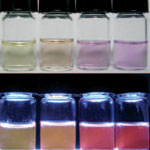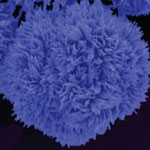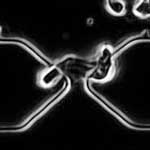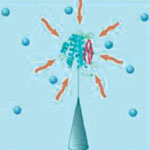Showing Spotlights 185 - 192 of 237 in category All (newest first):
 Over the past few years, scientists have taken advantage of the unique optical and other physical properties of metal nanoparticles to create a wide range of nanotechnology probes for electronic, optical, and microgravimetric transduction of different biomolecular recognition events. An interesting approach that was reported a couple of years ago deals with a technique that estimates the antioxidant power of certain food samples by measuring the generation and growth of gold nanoparticles. Researchers have built on these findings by developing a novel optical nanoprobe that can analyze the total reducing sugar content of samples. This technique could lead to the development of inexpensive and disposable optical nanoprobes that could find applications in a host of industrial, biomedical and clinical fields.
Over the past few years, scientists have taken advantage of the unique optical and other physical properties of metal nanoparticles to create a wide range of nanotechnology probes for electronic, optical, and microgravimetric transduction of different biomolecular recognition events. An interesting approach that was reported a couple of years ago deals with a technique that estimates the antioxidant power of certain food samples by measuring the generation and growth of gold nanoparticles. Researchers have built on these findings by developing a novel optical nanoprobe that can analyze the total reducing sugar content of samples. This technique could lead to the development of inexpensive and disposable optical nanoprobes that could find applications in a host of industrial, biomedical and clinical fields.
Mar 24th, 2009
 In physics, a plasmon is the quasi-particle resulting from the quantization of plasma oscillations just as photons and phonons are quantizations of light and sound waves, respectively. As the name indicates, surface plasmons are those plasmons that are confined to surfaces. The control of these surface plasmons has become increasingly attractive for optical signal processing, surface enhanced spectroscopy and sensor nanotechnology. The plasmonic properties of nanoparticles depend on various parameters such as their size or shape, and the refractive index of the environment. Surface plasmons form the basis of localized surface plasmon resonance (LSPR) sensing, which allows the detection of single molecules. Researchers have now demonstrated for the first time that the absorption and emission properties of few-atom metal nanoclusters respond dramatically to changes in the chemical environment.
In physics, a plasmon is the quasi-particle resulting from the quantization of plasma oscillations just as photons and phonons are quantizations of light and sound waves, respectively. As the name indicates, surface plasmons are those plasmons that are confined to surfaces. The control of these surface plasmons has become increasingly attractive for optical signal processing, surface enhanced spectroscopy and sensor nanotechnology. The plasmonic properties of nanoparticles depend on various parameters such as their size or shape, and the refractive index of the environment. Surface plasmons form the basis of localized surface plasmon resonance (LSPR) sensing, which allows the detection of single molecules. Researchers have now demonstrated for the first time that the absorption and emission properties of few-atom metal nanoclusters respond dramatically to changes in the chemical environment.
Mar 11th, 2009
 The thing with technology is that the science behind it isn't good or bad but the way it is used could make all the difference. There are plenty of examples throughout history. Military nanotechnology is a good present day example. And we don't even need to talk about the weird, far-out stuff like nanobots and the Casimir force. Take explosives. While on one side there is research going on to improve high explosives through nanoscale structuring, other research teams are putting a lot of effort into detecting ever smaller trace amounts of explosives and building the ultimate nanoscale bomb dog. A recent example has been demonstrated by scientists in China, who obtained organic super-nanostructures via a simple solution process, and, for the first time, demonstrated that such structures can be applied as chemosensors to detect explosives.
The thing with technology is that the science behind it isn't good or bad but the way it is used could make all the difference. There are plenty of examples throughout history. Military nanotechnology is a good present day example. And we don't even need to talk about the weird, far-out stuff like nanobots and the Casimir force. Take explosives. While on one side there is research going on to improve high explosives through nanoscale structuring, other research teams are putting a lot of effort into detecting ever smaller trace amounts of explosives and building the ultimate nanoscale bomb dog. A recent example has been demonstrated by scientists in China, who obtained organic super-nanostructures via a simple solution process, and, for the first time, demonstrated that such structures can be applied as chemosensors to detect explosives.
Jan 16th, 2009
 Scintillation - a flash of light, lasting only nanoseconds to microseconds, produced in a particular material when it absorbs ionizing radiation - is one of the main methods used for the detection of ionizing radiation. Scintillators are very versatile and can be used for detecting almost all types of radiation in a wide range of energy from several electron volts (eV) to tens of billion of electron volts (GeV). Scintillation is useful for sensing alpha, beta and gamma radiation as well as other nuclear particles and in some cases determining the particle type. For example, organic scintillators can sense fast neutrons emitted spontaneously from fissile isotopes of uranium and plutonium, enabling passive detection of nuclear weapons. The detection and identification of subatomic particles is not only important for nuclear nonproliferation efforts but is a wide-ranging scientific problem with implications for medical devices, radiography, biochemical analysis, particle physics, and even astrophysics. Scientists from the Sandia National Laboratories in California have now proposed that metal-organic frameworks (MOFs) could potentially offer the desired level of structural control, leading to an entirely new class of radiation detection materials.
Scintillation - a flash of light, lasting only nanoseconds to microseconds, produced in a particular material when it absorbs ionizing radiation - is one of the main methods used for the detection of ionizing radiation. Scintillators are very versatile and can be used for detecting almost all types of radiation in a wide range of energy from several electron volts (eV) to tens of billion of electron volts (GeV). Scintillation is useful for sensing alpha, beta and gamma radiation as well as other nuclear particles and in some cases determining the particle type. For example, organic scintillators can sense fast neutrons emitted spontaneously from fissile isotopes of uranium and plutonium, enabling passive detection of nuclear weapons. The detection and identification of subatomic particles is not only important for nuclear nonproliferation efforts but is a wide-ranging scientific problem with implications for medical devices, radiography, biochemical analysis, particle physics, and even astrophysics. Scientists from the Sandia National Laboratories in California have now proposed that metal-organic frameworks (MOFs) could potentially offer the desired level of structural control, leading to an entirely new class of radiation detection materials.
Jan 14th, 2009
 Olfaction, our sense of smell, depends on the capability of specialized sensory cells in the nose to detect airborne odorant molecules. These olfactory cells contain specific protein molecules that acts as 'olfactory receptors' - they bind only to specific odorant molecules present in the air inhaled through the nose. When such a binding event occurs, the olfactory receptors change their shape and this deformation triggers chemical and electrical signals which are eventually transmitted to the brain through neurons. So, in a nutshell, this is how we smell. Human and especially some animal noses (think bomb-sniffing dogs) are very sophisticated and extremely sensitive gas sensors that can distinguish between very similar gas molecules. Researchers have been trying for a while to replicate the human olfactory sense - a concept called electronic nose (e-nose). While most nanotechnology-based efforts have focused on nanowires, new research conducted in Korea has demonstrated the detection of specific odorant molecules with a single-carbon-atomic resolution using a human olfactory receptor-functionalized carbon nanotube based sensor.
Olfaction, our sense of smell, depends on the capability of specialized sensory cells in the nose to detect airborne odorant molecules. These olfactory cells contain specific protein molecules that acts as 'olfactory receptors' - they bind only to specific odorant molecules present in the air inhaled through the nose. When such a binding event occurs, the olfactory receptors change their shape and this deformation triggers chemical and electrical signals which are eventually transmitted to the brain through neurons. So, in a nutshell, this is how we smell. Human and especially some animal noses (think bomb-sniffing dogs) are very sophisticated and extremely sensitive gas sensors that can distinguish between very similar gas molecules. Researchers have been trying for a while to replicate the human olfactory sense - a concept called electronic nose (e-nose). While most nanotechnology-based efforts have focused on nanowires, new research conducted in Korea has demonstrated the detection of specific odorant molecules with a single-carbon-atomic resolution using a human olfactory receptor-functionalized carbon nanotube based sensor.
Jan 8th, 2009
 Miniaturizing traditional laboratory assays to automated lab-on-a-chip devices holds tremendous potential for enabling multiplex, efficient, cost-effective and accurate pathogen sensing systems for both security and medical applications. These sensors could be used to detect bacteria such as E. coli and Salmonella, but also other pathogens that could be used for bioterrorism. Traditional identification methods required time intensive cell culturing processes but novel pathogen sensors based on nanomaterials are promising vastly improved and speedy detection technologies. A recent example is a label-free sensor chip assembled from peptide nanotubes that enables the electrical detection of viruses with an extremely low detection limit. This could lead to compact super-sensitive pathogen detection chips for point of care applications that have a high tolerance against false-positive signals.
Miniaturizing traditional laboratory assays to automated lab-on-a-chip devices holds tremendous potential for enabling multiplex, efficient, cost-effective and accurate pathogen sensing systems for both security and medical applications. These sensors could be used to detect bacteria such as E. coli and Salmonella, but also other pathogens that could be used for bioterrorism. Traditional identification methods required time intensive cell culturing processes but novel pathogen sensors based on nanomaterials are promising vastly improved and speedy detection technologies. A recent example is a label-free sensor chip assembled from peptide nanotubes that enables the electrical detection of viruses with an extremely low detection limit. This could lead to compact super-sensitive pathogen detection chips for point of care applications that have a high tolerance against false-positive signals.
Dec 2nd, 2008
 Genomics and proteomics, the studies of genes and proteins, provide the underlying basis for many advances in drug development and effective treatments of diseases. These studies heavily rely on unveiling the behavior of a single DNA or protein in an investigative sample. You could compare this challenge to somehow finding, then catching and monitoring a particular fish in a vast ocean. The scientific term for 'catching the fish' is 'immobilization' - a powerful technique for the study of biochemical systems that allows for the continuous observation of dynamic behavior of a chosen target. Immobilization methods anchor the to be observed molecule onto a surface in order to restrict it from escaping the observation volume. Researchers have now developed a new platform which consists of a carbon nanotube nanoneedle for capturing, isolating and measuring the activity of miniscule amounts of proteins.
Genomics and proteomics, the studies of genes and proteins, provide the underlying basis for many advances in drug development and effective treatments of diseases. These studies heavily rely on unveiling the behavior of a single DNA or protein in an investigative sample. You could compare this challenge to somehow finding, then catching and monitoring a particular fish in a vast ocean. The scientific term for 'catching the fish' is 'immobilization' - a powerful technique for the study of biochemical systems that allows for the continuous observation of dynamic behavior of a chosen target. Immobilization methods anchor the to be observed molecule onto a surface in order to restrict it from escaping the observation volume. Researchers have now developed a new platform which consists of a carbon nanotube nanoneedle for capturing, isolating and measuring the activity of miniscule amounts of proteins.
Oct 3rd, 2008
 Artificial skin already exists that can detect pressure and recently, thanks to carbon nanotube rubber, it now even is stretchable. Then there is stretchable artificial skin that is used, for instance, to provide grafts for human burns victims, but it is insensitive to heat and pressure. Skin-like sensitivity, or the capability to recognize tactile information, will be an essential feature of future generations of robots. Of course you could also dream up some sci-fi scenarios where artificial electronic skin vastly enhances human perception and performance. The development of electronic skin requires high-performance tactile sensors that mimic human skin in terms of touch sensation over a large area, high flexibility, resolution, and sensitivity comparable to a human finger, as well as ease of signal extraction for speed and implementation. A recent review article summarizes the current state of developing artificial touch, an area where significant progress has been made over the past few years.
Artificial skin already exists that can detect pressure and recently, thanks to carbon nanotube rubber, it now even is stretchable. Then there is stretchable artificial skin that is used, for instance, to provide grafts for human burns victims, but it is insensitive to heat and pressure. Skin-like sensitivity, or the capability to recognize tactile information, will be an essential feature of future generations of robots. Of course you could also dream up some sci-fi scenarios where artificial electronic skin vastly enhances human perception and performance. The development of electronic skin requires high-performance tactile sensors that mimic human skin in terms of touch sensation over a large area, high flexibility, resolution, and sensitivity comparable to a human finger, as well as ease of signal extraction for speed and implementation. A recent review article summarizes the current state of developing artificial touch, an area where significant progress has been made over the past few years.
Sep 30th, 2008
 Over the past few years, scientists have taken advantage of the unique optical and other physical properties of metal nanoparticles to create a wide range of nanotechnology probes for electronic, optical, and microgravimetric transduction of different biomolecular recognition events. An interesting approach that was reported a couple of years ago deals with a technique that estimates the antioxidant power of certain food samples by measuring the generation and growth of gold nanoparticles. Researchers have built on these findings by developing a novel optical nanoprobe that can analyze the total reducing sugar content of samples. This technique could lead to the development of inexpensive and disposable optical nanoprobes that could find applications in a host of industrial, biomedical and clinical fields.
Over the past few years, scientists have taken advantage of the unique optical and other physical properties of metal nanoparticles to create a wide range of nanotechnology probes for electronic, optical, and microgravimetric transduction of different biomolecular recognition events. An interesting approach that was reported a couple of years ago deals with a technique that estimates the antioxidant power of certain food samples by measuring the generation and growth of gold nanoparticles. Researchers have built on these findings by developing a novel optical nanoprobe that can analyze the total reducing sugar content of samples. This technique could lead to the development of inexpensive and disposable optical nanoprobes that could find applications in a host of industrial, biomedical and clinical fields.
 Subscribe to our Nanotechnology Spotlight feed
Subscribe to our Nanotechnology Spotlight feed





